Cooking Calrose rice is an art that combines simplicity with precision, yielding perfectly textured grains every time. This medium-grain rice is ideal for various dishes, requiring attention to water ratios and technique for optimal results.
Overview of Calrose Rice
Calrose rice is a medium-grain variety, known for its creamy texture and mild flavor, making it a popular choice for both home cooking and restaurant dishes. Originating in California, it is widely used in Asian cuisines and is ideal for sushi, curries, and stir-fries due to its sticky yet tender consistency. This versatile rice holds its shape well when cooked and absorbs flavors effortlessly, enhancing the overall dining experience. Its mild taste pairs perfectly with a variety of seasonings, making it a staple in many kitchens. Whether prepared in a rice cooker or on the stovetop, Calrose rice consistently delivers a delightful texture and flavor.
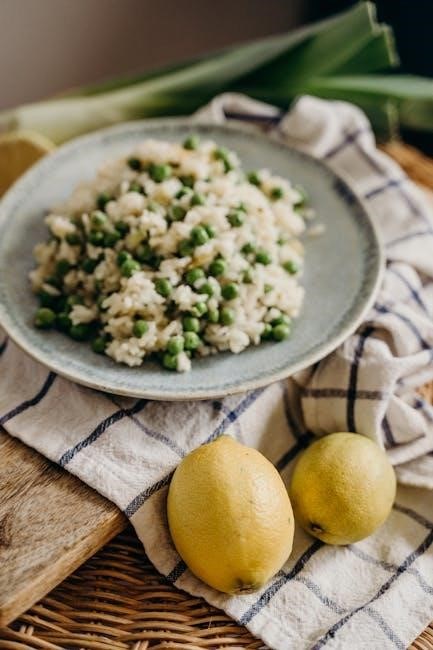
Importance of Proper Cooking Techniques
Proper cooking techniques are crucial for achieving perfectly cooked Calrose rice. Incorrect methods can result in undercooked, mushy, or dry grains, which compromise both texture and flavor. Using the right water-to-rice ratio, adequate rinsing, and appropriate heat control ensures each grain cooks evenly. Overlooking steps like rinsing can leave excess starch, leading to clumpiness. Similarly, using too little water may cause dryness, while excess water can make the rice soggy. Employing a rice cooker simplifies the process, maintaining optimal conditions for consistent results. Mastery of these techniques enhances the overall quality, making each serving of Calrose rice a delightful experience worth savoring.
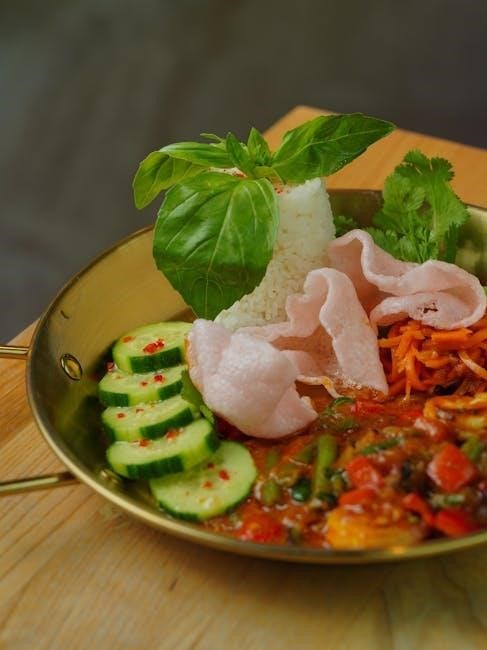
Understanding the Rice Cooker
A rice cooker simplifies the cooking process by automatically regulating water levels and heat, ensuring perfectly cooked rice with minimal effort.
Basic Components of a Rice Cooker
A standard rice cooker includes an inner pot for holding rice and water, a heating element for cooking, and a lid to trap steam. The thermal sensor detects when rice is done, automatically switching to keep-warm mode. The control panel offers settings for different rice types or delayed cooking. Some models include a non-stick coating for easy cleaning. Accessories like a measuring cup and spatula are often provided. These components work together to ensure consistent, stress-free cooking of Calrose rice, adapting to its medium-grain texture for perfect results every time. Understanding these parts helps maximize the cooker’s efficiency and your cooking experience.
Preparation Tips for Using a Rice Cooker
Before cooking, ensure the rice cooker is clean and dry. Wash the inner pot with mild soap and rinse thoroughly to prevent residue. Use the provided measuring cup for accurate water and rice proportions. Lightly oil the pot if using sticky rice or for easier cleanup. Avoid overfilling, as this can cause overflow during cooking. Pre-rinsing the rice beforehand is optional but can reduce starchiness. Pat dry excess moisture from rinsed rice before adding to the cooker. Always follow the manufacturer’s guidelines for water levels and settings. These steps ensure optimal performance and prevent damage to your rice cooker, guaranteeing perfectly cooked Calrose rice every time.
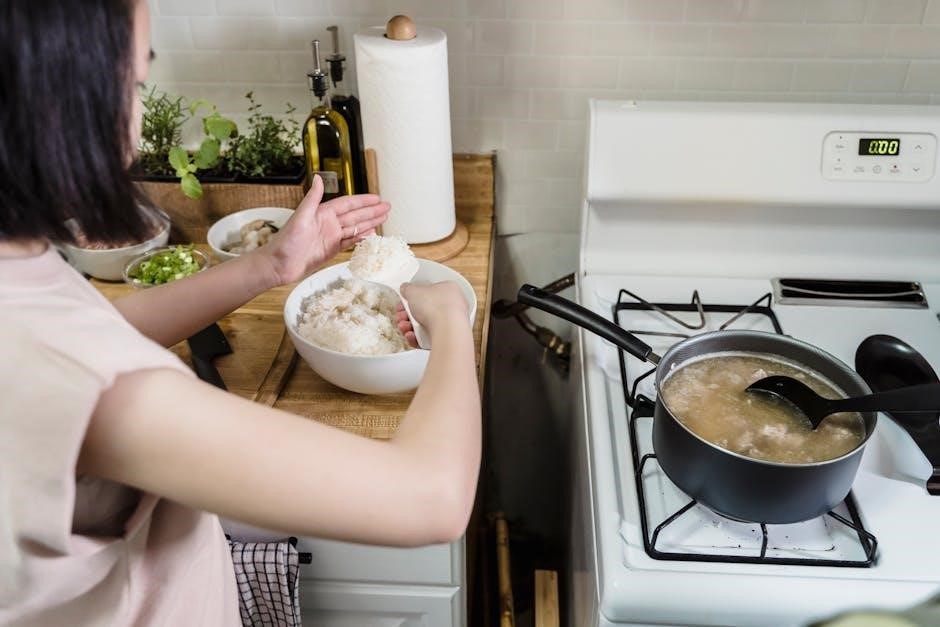
Preparing Calrose Rice
Rinsing Calrose rice under warm water removes excess starch, ensuring fluffy grains. Measure rice and water accurately, typically using a 1:1 ratio for optimal texture.
Rinsing the Rice
Rinsing Calrose rice is essential to remove excess starch, impurities, and any unwanted particles, ensuring a cleaner flavor and fluffier texture. Use a fine mesh strainer under warm running water, gently agitating the rice with your hands to loosen starches. Rinse until the water runs clear or nearly clear, typically requiring 2-3 rinses. This step prevents clumping and reduces the glycemic index slightly. Proper rinsing enhances the rice’s ability to cook evenly and absorb the right amount of water during the cooking process. Avoid overly vigorous rinsing to prevent breaking the grains. Once rinsed, the rice is ready for measuring and cooking in your rice cooker.
Measuring Rice and Water
Accurate measurement of Calrose rice and water is crucial for achieving the perfect texture. For Calrose rice, the general water-to-rice ratio is 1:1.2 to 1:1.3, meaning 1.2 to 1.3 cups of water for every 1 cup of rice. Use a measuring cup for precise quantities. If using a rice cooker, align the water level with the markings corresponding to the amount of rice added. Overfilling can result in mushy rice, while too little water may leave it undercooked. Always refer to your rice cooker’s guidelines for specific ratio recommendations. Proper measurement ensures the rice cooks evenly, with a tender yet separate grain texture, essential for both flavor and presentation.
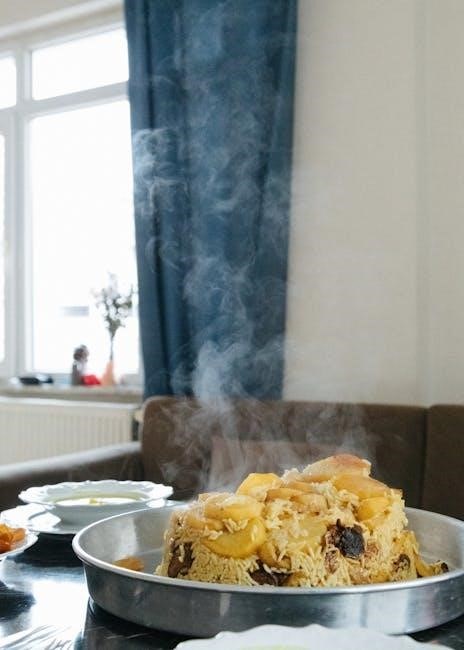
Cooking Calrose Rice
Cooking Calrose rice involves using a rice cooker for consistent results. Add measured rice and water, then let the cooker do the work. After cooking, let it rest for 10-15 minutes before fluffing.
Using the Rice Cooker
Using a rice cooker simplifies the process of cooking Calrose rice. Start by adding rinsed rice to the cooker. Measure the water according to the recommended ratio, typically 1:1 for Calrose rice, and pour it over the rice. Ensure the rice is evenly spread and the water level aligns with the cooker’s guidelines. Turn on the cooker and select the appropriate setting, usually the “white rice” mode. Allow the cooker to complete the cycle, which automatically adjusts heat for optimal results. Once cooked, let the rice rest for 10-15 minutes with the lid closed to steam evenly. Then, fluff the rice gently with a fork before serving.
Water-to-Rice Ratio for Calrose Rice
The water-to-rice ratio is crucial for achieving perfectly cooked Calrose rice. Generally, a 1:1 ratio is recommended, meaning one cup of water for every one cup of rice. This ratio ensures the rice cooks evenly without becoming too mushy or dry. For larger quantities, such as 3 cups of rice, use 3 cups of water. Some recipes suggest a slightly adjusted ratio, like 2 cups of water for 1.5 cups of rice, to enhance texture. Using a rice cooker simplifies this process, as it automatically adjusts to the correct water level. Adjustments may be needed based on personal preference or altitude for optimal results.
Optional: Soaking the Rice
Soaking Calrose rice can enhance its texture and reduce cooking time. Rinse the rice thoroughly, then soak it in water for 20-30 minutes. After soaking, drain the water and proceed with cooking. This step helps remove excess starch, resulting in fluffier grains. While optional, soaking is a simple way to improve the final texture.
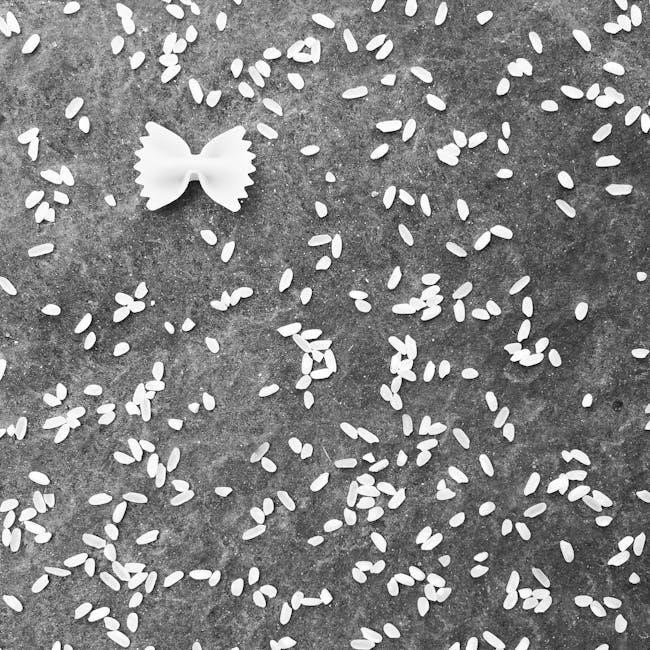
Seasoning and Enhancing Flavor
Add salt or seasonings like herbs, spices, or broth to the water before cooking for extra flavor. This step enhances the taste of Calrose rice naturally.
Adding Salt or Seasonings
Add salt or seasonings directly to the water in the rice cooker before cooking for enhanced flavor. This ensures the rice absorbs the seasonings evenly as it cooks. For a savory touch, mix in herbs like thyme or rosemary, or use broth instead of water for added depth. Optional: Stir in soy sauce or sesame oil for an Asian-inspired taste. Adjust seasoning quantities to your preference, but start light to avoid over-seasoning. Remember, seasonings are optional, so feel free to experiment or keep it simple for a traditional taste.
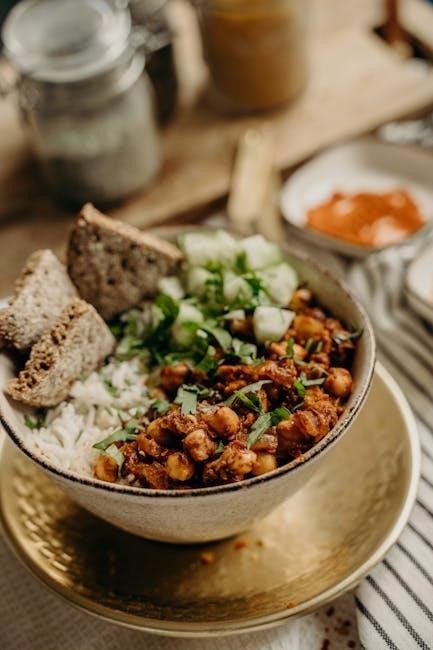
Post-Cooking Steps
After cooking, let the rice rest in the cooker with the lid closed for 10-15 minutes. Gently fluff the rice with a fork to separate the grains evenly.
Letting the Rice Rest
After cooking, allow the rice to rest undisturbed in the rice cooker with the lid on for 10 to 15 minutes. This crucial step ensures steam is evenly distributed, preventing sogginess and promoting fluffiness. The resting period allows the rice to cool slightly and retain its texture, making it easier to fluff later. Avoid opening the lid during this time, as releasing steam too early can lead to uneven cooking. Patience here guarantees perfectly cooked Calrose rice, ready for serving or further seasoning. This simple step is essential for achieving the desired texture and consistency in your final dish.
Fluffing the Rice
Fluffing the rice is a final step that ensures a light, airy texture. Once the rice has rested, gently stir it with a fork or rice paddle, breaking up any clumps. This process separates the grains, preventing them from sticking together and achieving the desired fluffiness. Be careful not to over-fluff, as it can make the rice mushy. Fluffing distributes heat evenly and ensures the rice cools slightly, making it ready for serving. Proper fluffing enhances the overall texture and appearance, preparing the Calrose rice for any dish, whether it’s a side, sushi, or a base for other recipes.
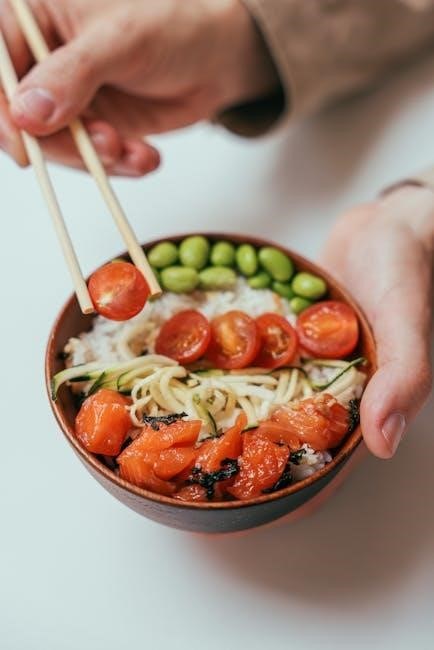
Tips for Perfect Calrose Rice
Use fresh, high-quality rice for best results. Ensure the rice cooker is clean to avoid residue affecting flavor. Monitor water levels to prevent overflow. Adjust settings for different rice varieties if your cooker allows it.
Common Mistakes to Avoid
When cooking Calrose rice, avoid rinsing excessively, as it removes nutrients and starch, leading to separated grains. Using the wrong water-to-rice ratio is another error—too much water results in mushy rice, while too little leaves it undercooked. Neglecting to let the rice rest after cooking allows steam to escape, affecting texture. Overstirring during cooking can break the grains, making the rice sticky. Additionally, using old or poor-quality rice can impact flavor and texture. Lastly, not cleaning the rice cooker regularly can cause residual flavors to affect the taste of the rice. Avoiding these mistakes ensures perfectly cooked Calrose rice every time.
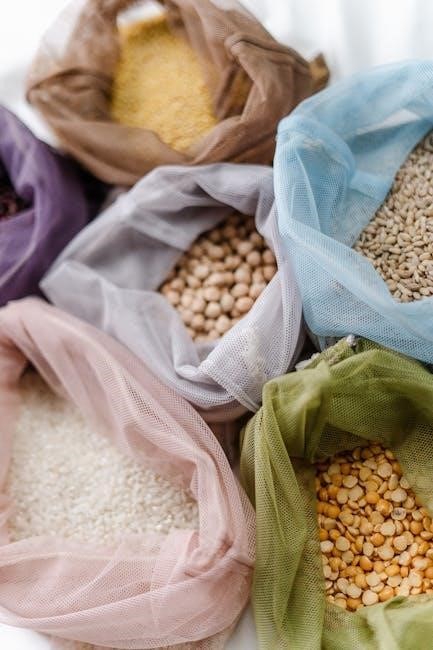
Storing Cooked Rice
Cooked Calrose rice should be stored properly to maintain freshness and safety. Cool the rice to room temperature within an hour of cooking to prevent bacterial growth. Transfer it to an airtight container and refrigerate within two hours. Cooked rice can be stored in the fridge for 3 to 5 days or frozen for up to 3 months. When freezing, portion the rice into sealed containers or freezer bags to avoid freezer burn; Label containers with dates for easy tracking. Reheat rice safely by steaming or microwaving with a splash of water to restore moisture. Never leave cooked rice at room temperature for extended periods, as it can spoil quickly.
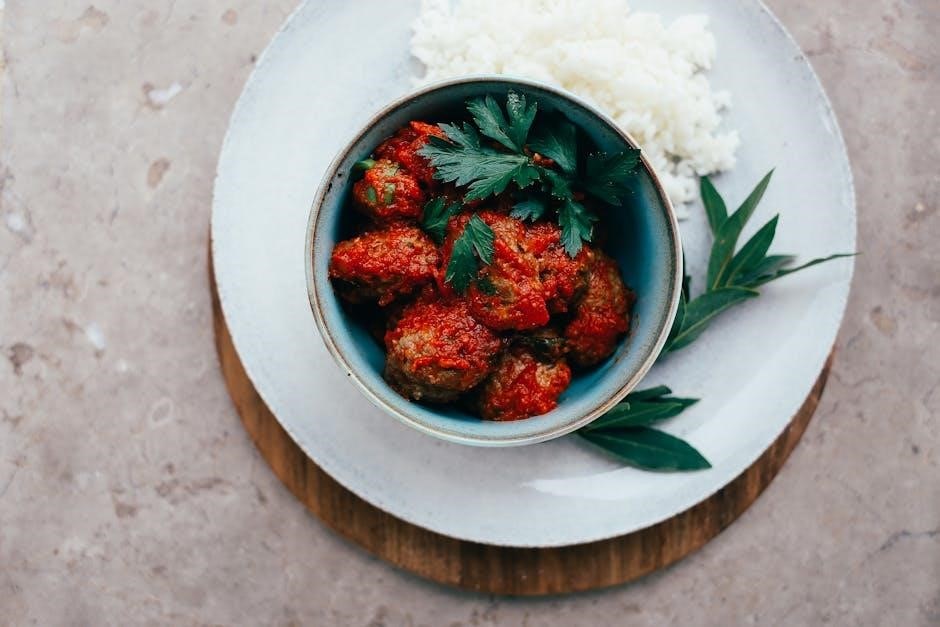
Troubleshooting
Common issues when cooking Calrose rice include undercooked or overcooked grains, sticking, or mushiness. If rice is undercooked, check water levels and ensure the rice cooker is sealed properly. Overcooked or mushy rice may result from excessive water or improper ratio. Adjust the water-to-rice ratio and allow the rice to rest after cooking. For sticking, ensure the rice cooker is non-stick or lightly oiled. Prevent overcooking by avoiding extended warming cycles. If rice is dry, fluff it gently with a fork and add a splash of water before reheating. Addressing these issues ensures perfectly cooked Calrose rice every time.
Cooking Calrose rice with a rice cooker is a straightforward process that yields consistent results when proper techniques are followed. By rinsing the rice, using the correct water-to-rice ratio, and allowing it to rest, you ensure fluffy and flavorful grains. Experimenting with seasonings or additional ingredients can further enhance the dish. Remember, practice makes perfect, so don’t hesitate to refine your method over time. With these simple steps, you’ll master the art of cooking Calrose rice, making it a delightful staple in your meals.

